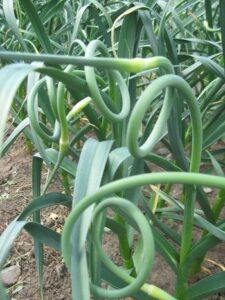In this post, I will be taking a break from describing different types of gourmet garlic to discuss garlic scapes, also called garlic shoots, stems or greens. Scapes are the flowering central stalk of hardneck garlic varieties, and the time for their removal is fast approaching. Whether you grow gourmet garlic for market or merely for your own consumption, scape removal can be crucial to the size of your bulbs at harvest, and can also provide you with additional income and edibles.
Growth
The season for scapes is very short, only a few weeks. After the last of the leaves have emerged from the center of the garlic plant, the spathe, the beaked leaf containing the umbel, will begin to appear. Within the bulbous umbel are the bulbils, the tiny, clove-like structures which can be planted or eaten. Supporting the umbel and spathe is a long solid stalk, the scape.
The scape will grow straight upwards for a number of inches, before beginning to curl. This characteristic curling is due to the cells on one side of the stalk lengthening before those on the other side. The number of curls that the scape will achieve depends on the type of garlic, but most will curl at least once, often twice, and occasionally a third time, before straightening and continuing to grow upwards to heights of four to seven feet. Before and during curling, the scapes have a crisp but tender texture, but once they have straightened and continue to grow, they become hard and wooden.
Removing Garlic Scapes
Although scapes can be left on the garlic plant to mature, many growers find that this negatively affects the size achieved by the bulb at the time of harvest. Subsequently, the scapes are removed in order to encourage the plant to put all of its available energy into producing as large a bulb as possible, rather than split its resources between bulbing and flower production. This does not mean that you should remove the scapes as soon as you see them, however, since removing them too early has been found to compromise the longevity of bulb storage.
Scape removal is more essential to bulb size in certain types of garlic than in others. Purple Stripes, Glazed Purple Stripes, Marbled Purple Stripes, Porcelains, and Creole varieties all tend to produce significantly smaller bulbs if the scapes are not removed. Rocamboles tend to be moderately affected, and in Asiatic and Turban types, scape removal seems to make very little difference in the overall size of mature bulbs. Keep in mind that if you are intending to plant bulbils from your cultivars, the scapes must be left on the plants until the flowering stalk is mature.
Although you can experiment to determine when the best time to remove the scapes of your particular cultivars may be, a good general time to remove them is after they have curled and just before or as they begin to straighten. We find that this timing gives us a good balance between bulb size and storage capability. If you grow a sizable amount of garlic, like we do, you can’t afford to be too picky about when you can get it done!
It is best to take off the scapes on a day when it is warm and dry, as their removal will leave an open wound on the plant. A sunny day will allow the newly raw portion to dry and scab over quickly, which will help prevent any harmful bacteria from entering the garlic. When the scapes are still tender-crisp they can usually be snapped off cleanly by hand, but once they begin to harden, and sometimes in more robust plants, they need to be removed with clippers or shears. If you are breaking the scapes off by hand, wear gloves, as the stems will produce a ‘sap’ that can feel somewhat corrosive and can make your skin red, sore and itchy. Likewise, if you are cutting your scapes, use a sharp, clean implement and be sure to wash it at the end of every day, as the exudate will cause the blades to rust. Remove the scapes lower down, about half an inch above the top leaf.
Cooking With Garlic Scapes
Scapes continue to grow in popularity in Western cuisine as greater numbers of people become more familiar with them, increasing demand and making them more readily available. You can often find them at Farmers Markets and some grocery stores when they are in season, but many Asian grocery stores will carry them year round. The local season for scapes is very short, usually two, sometimes three weeks, so keep an eye out for them or you may find the season over before you even knew it had begun! In our area, scape season tends to begin in mid to late June, but this window may vary in other regions, so ask your local grower about availability.
When buying scapes, make sure they are still young, as they are curling or just before, otherwise the texture can be unpalatable. The ideal texture should be similar to asparagus or broccoli raab stems – tender-crisp and easily snapped. Scapes have a mild to medium strong garlic flavor and are very versatile. They can be grilled, steamed, enjoyed fresh, pickled, and added to a variety of dishes, from pizzas to stir-fries. You can actually substitute scapes in most recipes calling for garlic, although the taste will usually be milder.
You can find a number of delicious scape recipes atour recipe box on Tumblr. Enjoy!




